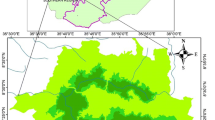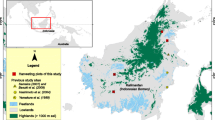Abstract
Forest tree biomass estimation is a significant issue for the forest management system and to mitigate climate change. Aboveground biomass (AGB) is an indicator of the potential productivity of the ecosystem. However, an accurate estimation method of carbon stock is important for perfect carbon accounting. So, selecting a more appropriate method for biomass assessment is crucial to reaching the goal. Though allometric equations have been used to estimate AGB for both individual species as well as multiple species for regional and pan-tropical scales, species-specific models for a smaller area produce better accuracy. The current initiative has been taken to develop individual tree-level species-specific and generalized local allometric models in a non-destructive manner for the Tripura state of Northeast India, which was the main limitation of carbon stock estimation in the region. Five different forms of log-transformed linearized power equations were tested in the regression models, with AGB as the response variable. The best fit models were chosen based on adjusted R2, F-statistic, Akaike information criterion, Breusch-Pagan test, Variance Inflation Factor, and three assumptions of linearity. A paired t test was conducted between the predicted and observed AGB values. The best fit generalized equation developed in this study was found to be AGB = 1.03 × exp (− 3.95 + 1.09 ln D2 + 0.97 ln H − 0.20 N). Compared with some existing pan-tropical and regional models for their predictive accuracy, this equation expressed the highest R2 value of 0.9089 in an independent testing dataset. When measuring the tree height is difficult due to a closed canopy, the equation AGB = 1.07 × exp (− 2.77 + 2.55 ln D) can be applied to obtain a quick estimation using just the DBH. The equations presented here may be the instrument for estimating carbon stock at the local level.




Similar content being viewed by others
Data availability
The authors declare that the data used in this article are our collection.
References
Alam K, Nizami SM (2014) Assessing biomass expansion factor of birch tree Betula utilis D. Don. Open J For 4:181–190
Baishya R, Barik SK, Upadhaya K (2009) Distribution pattern of aboveground biomass in natural and plantation forests of humid tropics in Northeast India. Trop Ecol 50(2):295
Banik B, Deb D, Deb S, Datta BK (2018) Assessment of biomass and carbon stock in sal (Shorea robusta Gaertn.) forests under two management regimes in Tripura, Northeast India. J For Env Sci 34(3):209–223
Basuki TM, Van Laake PE, Skidmore AK, Hussin YA (2009) Allometric equations for estimating the aboveground biomass in tropical lowland Dipterocarp forests. For Ecol Manag 257(8):1684–1694
Berenguer E, Ferreira J, Gardner TA, Aragão LEOC, De Camargo PB, Cerri CE, Durigan M, Oliveira RCD, Vieira ICG, Barlow J (2014) A large-scale field assessment of carbon stocks in human‐modified tropical forests. Glob Change Biol 20(12):3713–3726
Bora N, Nath AJ, Das AK (2013) Aboveground biomass and carbon stocks of tree species in tropical forests of Cachar District, Assam, Northeast India. Int J Ecol Environ Sci 39(2):97–106
Brown S. (1997) Estimating biomass and biomass change of tropical forests: a primer. For the food and agriculture organization of the United Nations. Rome, 1997. FAO Forestry Paper – 134. ISBN 92-5-103955-0
Brown S, Gillespie AJ, Lugo AE (1989) Biomass estimation methods for tropical forests with applications to forest inventory data. For Sci 35(4):881–902
Chambers JQ, Santos DJ, Ribeiro RJ, Higuchi N (2001) Tree damage, allometric relationships, and aboveground net primary production in central Amazon forest. For Ecol Manag 152(1–3):73–84
Champion HG, Seth SK (1968) A revised survey of the forest types of India. Government of India, Delhi
Chave J (2006) Measuring wood density for tropical forest trees. A field manual for the CTFS sites 1–7
Chave J, Andalo C, Brown S, Cairns MA, Chambers JQ, Eamus D, Fölster H, Fromard F, Higuchi N, Kira T et al (2005) Tree allometry and improved estimation of carbon stocks and balance in tropical forests. Oecologia 145(1):87–99
Chave J, Réjou-Méchain M, Búrquez A, Chidumayo E, Colgan MS, Delitti WB, Duque A, Eid T, Fearnside PM, Goodman RC, Henry M (2014) Improved allometric models to estimate the aboveground biomass of tropical trees. Glob Change Biol 20(10):3177–3190
Choudhary BK, Majumdar K, Datta BK (2017) Tree diversity and ecosystem carbon stock patterns along selected land use, land cover systems in Tripura, Northeastern India. Int J Ecol Environ Sci 42(5):91–106
Curtis RO (1967) Height-diameter and height-diameter-age equations for second-growth Douglas-fir. For Sci 13(4):365–375
Deb DB (1981–1983) The Flora of Tripura State. Vols. 1–2, Today and Tomorrow’s Printers and Publishers, New Delhi
Djomo AN, Knohl A, Gravenhorst G (2011) Estimations of total ecosystem carbon pools distribution and carbon biomass current annual increment of a moist tropical forest. For Ecol Manag 261(8):1448–1459
FAO (2015) Evaluation des ressources forestières mondiales 2015, 2nd edn. FAO, Rome
FSI (2011) India State of Forest Report 2011, Forest Survey of India. Ministry of Environment and Forests, Dehradun
FSI (2019) India State of Forest Report. Forest Survey of India. Ministry of Environment and Forests, Dehradun
Hamner B, Frasco M, LeDell E (2020) Evaluation metrics for machine learning. R package version 0.4-0
Haripriya GS (2000) Estimates of biomass in Indian forests. Biomass Bioenergy 19(4):245–258
Huang S, Yang Y, Wang Y (2003) A critical look at procedures for validating growth and yield models. Modelling forest systems, Sesimbra, Portugal
Ketterings QM, Coe R, Noordwijk VM, Palm CA (2001) Reducing uncertainty in the use of allometric biomass equations for predicting aboveground tree biomass in mixed secondary forests. For Ecol Manag 146(1–3):199–209
King DA, Davies SJ, Tan S, Noor NSM (2006) The role of wood density and stem support costs in the growth and mortality of tropical trees. J Ecol 94(3):670–680
Mahmood H, Siddique MR, Costello L, Birigazzi L, Abdullah SR, Henry M et al (2019) Allometric models for estimating biomass, carbon and nutrient stock in the Sal zone of Bangladesh. IForest-Biogeosciences and Forestry 12(1):69
Majumdar K, Choudhary BK, Datta BK (2016) Aboveground Woody Biomass, Carbon Stocks Potential in Selected Tropical Forest Patches of Tripura, Northeast India. Open J Ecol 06(10):598–612. https://doi.org/10.4236/oje.2016.610057
Mensah S, Veldtman R, Toit DB, Kakaï GR, Seifert T (2016) Aboveground biomass and carbon in a South African mistbelt forest and the relationships with tree species diversity and forest structures. Forests 7(4):79
Nath AJ, Das AK (2011) Carbon storage and sequestration in bamboo-based smallholder homegardens of Barak Valley, Assam. Curr Sci 100(2):229–233
Nath AJ, Tiwari BK, Sileshi GW, Sahoo UK, Brahma B, Deb S, Devi NB, Das AK, Reang D, Chaturvedi SS, Tripathi OP, Das DJ, Gupta A (2019) Allometric models for estimation of forest biomass in North East India. Forests 10(2):103
Nossent J, Bauwens W. (2012) Application of a normalized Nash-Sutcliffe efficiency to improve the accuracy of the Sobol’sensitivity analysis of a hydrological model. In EGU General Assembly Conference Abstracts, p.237
Ogle DH, Wheeler P, Dinno A (2020) FSA: fisheries stock analysis. R package version 0.8.31
Pan Y, Birdsey RA, Fang J, Houghton R, Kauppi PE, Kurz WA et al (2011) A large and persistent carbon sink in the world’s forests. Science 333(6045):988–993
Paul KI, Radtke PJ, Roxburgh SH, Larmour J, Waterworth R, Butler D et al (2018) Validation of allometric biomass models: How to have confidence in the application of existing models. For Ecol Manag 412:70–79
Picard N, Saint-André L, Henry M (2012) Manual for building tree volume and biomass allometric equations: from field measurement to prediction. Manual for building tree volume and biomass allometric equations: from field measurement to prediction, FAO
Pressler M (1865) Das Gesetz der. Stambildung Leipzig, pp153
Salunkhe O, Khare PK, Kumari R, Khan ML (2018) A systematic review on the aboveground biomass and carbon stocks of Indian forest ecosystems. Ecol Processes 7:17
Sileshi GW (2014) A critical review of forest biomass estimation models, common mistakes and corrective measures. For Ecol Manag 329:237–254
Sprugel DG (1983) Correcting for bias in log-transformed allometric equations. Ecol (Durham) 64(1):209–210
Yan Y. (2016) Machine learning evaluation metrics. R package version 1.1.1
Zambrano-Bigiarini M. (2020) hydroGOF: Goodness-of-fit functions for comparison of simulated and observed hydrological time series. R package version 0.4-0
Zanne A, Lopez-Gonzalez G, Coomes D, Ilic J, Jansen S, Lewis S, Miller R, Swenson N, Wiemann M, Chave J. (2009) Global wood density database. dryad digital repository
Zeileis A, Hothorn T (2002) Diagnostic checking in regression relationships. R News 2(3):7–10
Zianis D, Mencuccini M (2004) On simplifying allometric analyses of forest biomass. For Ecol Manag 187(2–3):311–332
Acknowledgements
The authors would like to thank Dr. John A. Kershaw Jr., Professor of Forest Mensuration, University of New Brunswick, for his insight on the model selection process. The authors also thank Mr. Asim Kumar Kalai, Mr. R.M. Darlong of the Tripura Forest Department, and Mr. Abraham Halam for aiding in data collection.
Author information
Authors and Affiliations
Contributions
ADR: Conceptualization, Data collection, Investigation, and Writing the original draft. SKD: Data curation, Validation, and Writing the original draft. BD: Supervision and final editing.
Corresponding author
Ethics declarations
Conflict of interest
The authors declare no conflict of interest.
Consent to participate
Not applicable.
Consent to Publish
All authors consented to publish this research article in Tropical Ecology.
Rights and permissions
Springer Nature or its licensor (e.g. a society or other partner) holds exclusive rights to this article under a publishing agreement with the author(s) or other rightsholder(s); author self-archiving of the accepted manuscript version of this article is solely governed by the terms of such publishing agreement and applicable law.
About this article
Cite this article
Dutta Roy, A., Das, S.K. & Debnath, B. A non-destructive approach to develop tree-level allometric equations for estimating aboveground biomass in the forests of Tripura, Northeast India. Trop Ecol 64, 532–542 (2023). https://doi.org/10.1007/s42965-022-00280-8
Received:
Revised:
Accepted:
Published:
Issue Date:
DOI: https://doi.org/10.1007/s42965-022-00280-8




